[ad_1]
When shopping for your wedding dress, you should first consider which gown style you prefer. When selecting your wedding gown style, consider the silhouette, sleeves, neckline, bodice and train. Following is guide to the basic terminology of popular wedding gown styles.
The Silhouette
* A-line – The A-line or princess dress has no marked waist and the vertical seams flow from the shoulders down to a flowered skirt, creating a "A" shape.
* Ball Gowns – These gowns typically quite formal, reminding you of Cinderella. The bodice is fitted with a very full skirt.
* Empire – Empire gowns have a raised waistline that starts right under the bust, flowing to a slim (but not body-hugging) skirt.
* Mermaid – As the name indicates, the mermaid dress is contoured against the body then the gown flows out beginning around the knees. This is the sexiest of the styles.
* Sheath – The sheath or column dress has a slim shape that follows close to the line of the body. The straight design is form-fitting and does not allow for many body flaws.
The Sleeves
* 3/4 sleeves – end between the elbow and wrist.
* Bell – long sleeves, flare out toward the wrist creating a bell shape.
* Cap – rounded sleeves, just covering shoulders.
* Fitted point – long, fitted sleeves that come to a point over the hand.
* Juliet – long, fitted sleeves with puffy shoulders.
* Long sleeves – long sleeves that are typically form-fitting.
* Off-the-shoulder Sleeves – cover the upper part of the arm but leave the tops of shoulders exposed.
* Poet – long sleeves, fitted to the elbow then flared.
* Pouf – short sleeves, gathered to create a poufy look.
* Short sleeves – about the length of T-shirt sleeves.
* Sleeveless – strapless with no sleeves.
* Spaghetti straps – thin spaghetti straps with no sleeves.
The Neckline
* Bateau – close to straight across from the tip of the shoulder. Gives plenty of coverage.
* Halter – wraps around the back of the neck to create deep armholes. Often also a backless style, which is very sexy.
* High – covers most of the neck. Creates a formal, somewhat stiff look.
* Jewel – similar to that of a T-shirt. Creates a bustier look.
* Off-The-Shoulder – as the name indicates, the top of the shoulders are bare. Showcases your collarbone and shoulders.
* Portrait – a very wide scoop from the tip of one shoulder to the tip of the other.
* Scoop – classic U-shaped neckline. Can be cut low for a more sexy look.
* Square – squared neckline, often associated with empire gowns.
* Strapless – normally straight across. Not recommended for women with small busts.
* Sweetheart – shaped like the top half of a heart. Emphasizes the cleavage.
* V-Neck – dips in the front into a V-shape. Can be very deep.
The Bodice
The bodice reflects to the portion of the dress between the neckline and skirt.
* Corset – a form fitting bodice with boning and lace-up closures.
* Halter – sleeveless bodice that wraps around you neck, normally backless.
* Midriff – fits very close around the mid-section, accentuating your waist.
* Surplice – sections of fabric cross wrap in the front or back.
* Tank – sleeveless with wide armholes like tank top.
The Train
* Sweep – 8 "to 12" in length, just a few inches longer than the gown.
* Court – extends about 3 feet from the waist.
* Chapel – extends about 4 feet from the waist.
* Cathedral – extends about 6 to 9 feet from the waist.
* Royal – extends more than 9 feet from the waist.
The Veil
* Birdcage – falls right below the chin, usually attached to a headpiece.
* Flyaway – ends at the shoulder.
* Blusher – worn over your face, about 28 "long.
* Elbow Length – ends at the elbow or waist.
* Fingertip – ends at the finger tips or just below the waist.
* Ballet – ends at the ankles.
* Chapel – ends slightly longer than dress length.
* Cathedral – 9 feet or longer.
[ad_2]
Source by Melissa Ingram

